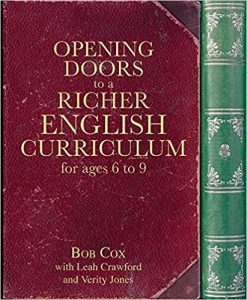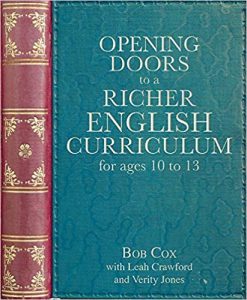What is Opening Doors?
Well, there’s a quick answer and one that will take us a little more time to explore.
The quick answer is that Opening Doors is a series of books for teachers of English published by Crown House. The books appear to be a relatively rare beast in the world of educational publishing. Why? Because they provide the texts and ideas for teaching sequences woven through with explanations for teachers on how and why the authors approach teaching in this way. The latest Opening Doors series were co-written by Bob Cox, Verity Jones and myself.
We aim to open doors to rich literature and the inspiration it provides to thinking and writing for teachers and pupils alike. The books may be our tangible product, but our impact and legacy happen live in classrooms, with teachers and pupils who dare to take risks and go deeper. Part of the Opening Doors process often means that we deliver professional development talks and workshops direct to leaders and teachers.
Click here to read blogs on Bob’s website by schools who have invested time and energy to weave Opening Doors through their English curriculum.
Use the form below to get in touch if your school, cluster, federation, MAT or organisation would like an Opening Doors keynote, presentation or full professional development workshop.
How about the more complex answer?
The curriculum subject of English has proven to be a slippery beast. It has suffered the slings and arrows of political, social and policy change perhaps more than other subjects as its aims, content and method have proven so open to influence. The Opening Doors team believes that English is a subject in its own right, not just a literacy service industry. At the core of that subject sits the shared exploration of rich, literary texts. This can and should include rich picture books, children’s and adult literature. In the words of Mary Roche, we should select core curriculum texts ‘that do not yield their meaning easily’. It is through grappling with difficulty, collectively, that we reach higher levels of understanding. Literature opens up dialogue into how texts work and how we might generate our own artistic meaning through language.
Let’s consider for a moment an extract from the opening of Walter de la Mare’s troubling short story The Riddle, published in 1923, which drives Unit 13 in “Opening Doors to Quality Writing 6-9’.
When the children were come out of the cab, they were shown into their grandmother’s presence. They stood in a little black group before the old lady, seated in her bow window. And she asked them each their names, and repeated each name in her kind, quavering voice.
Asking an open question like ‘What puzzles you about these events?’ Leads to teachers and children making more elaborative connections than literal retrieval questions could ever do. Readers tend to feel puzzled as to why a grandmother does not already know the names of her grandchildren. Why are they ‘shown in’, rather than met at the door by her? Being ‘shown in to her presence’ sounds very odd – this seems to reinforce the formality of the situation. What on earth does ‘little black group’ mean? Does this mean they are all wearing black? Why would that be? A funeral perhaps! Or is their mood black – do they not wish to be there, or might this simply suggest they are sad? How odd that we do not know – we are not introduced to – the children individually. Is seeing them as ‘a little black group’ how their grandmother sees them, or how the narrative voice wishes us to see them? Does the darkness suggest they will be naughty? Will they have different characters as we continue to read?
This narrative voice invites us into a world where the children have lost their identity, through the death of their father, and are plunged in to the kind but ‘quavering’ formality of the unknown world of their grandmother. In the next paragraph, De La Mare deftly introduces the narrative hook. Grandmother gives each child a gift, according to their age, and tells them they can play where they like apart from near the old oak chest in the attic. ‘Play anywhere else in the house, but not there.’ So of course, where will the children choose to play? And what will happen as a result…? Will they be punished for their digression, or come out unscathed?
In the mind of an experienced reader these exploratory thoughts can happen in hundredths of a second, generating character, story patterns and mood through dialogue with the text. In a classroom, we need to make time and space for such thoughts to emerge and be shared and considered, to construct the mind of a reader who is both open to uncertainty and in pursuit of plausible resonance in the meanings they create. This, in the words of Margaret Meek, is ‘how texts teach what readers learn’ – and only the richest of texts can teach such rich lessons.
We also believe in creative and critical writing as a route in to deeper understanding. Writing is another way to make one’s growing understanding visible and open to adaptation. Again, Margaret Meek put this beautifully when she said “If we want to see what lessons have been learned from the texts children read, we have to look for them in what they write.” She meant this in the broadest sense – lessons that may have been learned from the whole of their lives and culture, not only from the books we may journey through with them. Since Meek was writing in the late 1980’s there has been a growth in the act of critical rewriting as part of the English discipline at university level. With Opening Doors, we value the creativity of responding to texts in one’s own creative writing as much as through personal comment.
So for these reasons, in ‘The Old Oak Chest’ unit, children are encouraged to think about what the objects given to the children might tell us about them then apply this thinking to imagine what curious objects they might like to be given from an old house such as this and why. The class then reads up to the point where Henry, one of the children, takes himself apart from the others to see the old oak chest ‘in the evening twilight (of course!), feels its carved patterns ‘in the darkening dark’ and climbs inside. The next stage of the story is theirs to continue…
The Story of the Opening Doors book series
The first, ‘mother’ book was published in 2014. At the time, Bob Cox, an ex-Head of English and Local Authority advisor was working as an independent education consultant. In his work with schools, teachers were increasingly asking him how he sourced his texts and where he got his ideas from to design creative reading and writing journeys with access and depth for all. He wrote Opening Doors to Famous Poetry and Prose essentially at the request of teachers. Crown House publishers championed teachers’ desire to use heritage texts from Key Stage 2 to 3 to deepen thinking and understanding and inspire writing.
The success of the ‘mother’ book led to the second series, Opening Doors to Quality Writing in two companion volumes for ages 6-9 and 10-13. The leaning towards classic, ‘heritage’ texts remained: texts that without the ‘Opening Doors’ guidance might have seemed inaccessible or even inappropriate for primary and early KS3 pupils. A new emphasis was put on inspiring young people’s own writing through reading. The concept of ‘taster drafts’: preparing for reading through writing, experimenting with thoughts and ideas through drafting and redrafting in a social context, is emphasised to break the deadlock of writing at the end of a (long) reading sequence. The books, and Bob’s accompanying presentations and consultancy in the UK and internationally were genuinely pioneering. This was no easy route to improved test results, but a route to exploring how rich English could regenerate teachers’ and pupils’ motivation, engagement and improved outcomes through grappling with complexity.
Was the approach to hard? Too pioneering? Teachers said otherwise – and in 2017, the British Educational Resource Awards committee endorsed this by awarding the Opening Doors series first prize in the educational book category
“Described as two gems which provide innovative approaches to exploring quality texts as stimuli for children’s writing. Judges described ‘The Opening Doors to Quality Writing’ series is an invaluable resource, particularly for non-specialist teachers. Excellent literary choices contained within very attractively produced books.”
By this point, requests for Bob to present at events, provide professional development days and courses for single schools, MATs and LAs had led to team expansion! Myself and Verity Jones were taking on Opening Doors work and generating new opportunities in new areas.
Bob’s generosity and genuine belief in the strength of team-work spawned the idea for the new books, published in October 2019: Opening Doors to a Richer English Curriculum. The aim of this new series is to move the Opening Doors philosophy and approach firmly centre stage in the weaving of an English Curriculum.
So what’s new in the new series?
- The core quality texts are more diverse, across time, space and genre
- Lists of texts linked by concepts and themes are provided for curriculum depth and breadth
- Each Unit exemplifies a key strategy that can be reapplied to link texts and to writing
- Key strategies provide a route to developing conceptual understanding in English
- Excellent responses criteria are helpfully linked to concepts to build teacher knowledge and confidence






